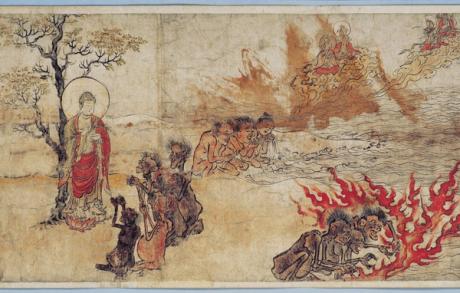The Chair
2012 - Installation (Installation)
Nandan Ghiya
The Chair (2012) foregrounds media-based tensions between analog and digital imaging technologies as a means of challenging the continued circulation of visual ephemera from India’s colonial past. A mix of found photographs and staged studio portraits deliberately made to look older, The Chair features multiple portraits of figures dressed in period costumes that reference the ornate fashions popular during Great Britain’s imperial rule of India. A hybrid frame wraps around this assemblage, a composite of variously ornate and simple wood finishes culled from disused and forgotten pictures. For each portrait, Ghiya obstructs the subject’s face with hand-painted squares resembling pixels, a gesture of willful obfuscation that renders the colonial subject anonymous while also drawing attention to the subtle but inherent violence of image taking. In using elements from both analog and digital photography, The Chair challenges the imagery and stereotypes of colonial India through contemporary digital technology, blurring the line between the historical and the contemporary, the past and the present. But if Ghiya investigates the issue of individuality in recent colonial past times and its successive iterations in a digital world, he also utilizes his practice as a means to reveal how all representation is effectively manipulated. His hand-painted pixels are more than just gestures towards an historical shift from analog to digital – they are marks of a decisive intervention and a reminder that all images are, in effect, produced by multiple layers of construction, artifice, and variant meaning.
Nandan Ghiya is an emerging whose practice explores the disjunction between various forms of image-based media. Although he received no formal training, his mixed media works reveal a savvy understanding of the function that photographs play in defining our perception of cultural and collective narratives. In juxtaposing found studio portraits alongside digitally manipulated images, Ghiya examines how advances in media-based technologies define our contemporary modes of perception while also threatening genealogies of rich indigenous histories. His work could be seen in conversation with artistic traditions of assemblage and collage. His deliberate commitment to handwork with acrylic, however, also suggests a deeper commitment to multidisciplinary practices that don’t entirely refute artistic traditions but instead utilize them to draw out more trenchant conversations about the erasure of cultural identities and modernism’s displacement of a traumatic colonial past.
Colors:
Related works sharing similar palette

© » KADIST
Julio Cesar Morales
2006Julio Cesar Morales’s watercolor drawings, Undocumented Intervention , show a variety of surprising hiding places assumed by people trying to cross into the United States without documentation...

© » KADIST
Imran Qureshi
2017At first glance, This Day by Imran Qureshi appears to be an energetic, gestural painting reminiscent of Action Painting from the mid-20th century...

© » KADIST
Jorge González
2017Easy to fold and carry, Jorge González’s Banquetas Chéveres (Chéveres Stools) embody the nomadic and flexible nature of the Escuela de Oficios...

© » KADIST
Jessica Warboys
2013The ongoing “Sea Paintings” series is central to the practice of Jessica Warboys...

© » GAS
New exclusive Marie Lenclos Paintings available – Gina Cross - Curator + Mentor Close Thin Icon Close Thin Icon Your cart Close Alternative Icon Now partnered with Art Money for interest free art collecting Now partnered with Art Money for interest free art collecting News Written by Gina Cross Previous / Next I’m pleased to present new and exclusive work by London artist Marie Lenclos who has created a series of 6 new works for us...

© » THEARTNEWSPER
Cities are the heroes in an 'easy-going and unpreachy' publication that takes us on whirlwind tour of art history Art market Museums & heritage Exhibitions Books Podcasts Columns Technology Adventures with Van Gogh Search Search Books review Cities are the heroes in an 'easy-going and unpreachy' publication that takes us on whirlwind tour of art history Fifteen art capitals are captured at their brilliant apogee in Caroline Campbell's book Keith Miller 6 February 2024 Share Detail of Hungry Ghosts Scroll (late 12th century) by an unknown artist Kyoto National Museum The last book I reviewed with this title was by the historian Simon Schama...

© » KADIST
Carla Zaccagnini
2018De sino à sina (From Bell to Fate) is a six-channel sound installation by Carla Zaccagnini exploring the relationship between modern Brazil and its colonial past...

© » SLASH PARIS
Camille Esayan, Lara Bouvet — Corps composé(s) — Hôpital européen Georges-Pompidou — Exposition — Slash Paris Connexion Newsletter Twitter Facebook Camille Esayan, Lara Bouvet — Corps composé(s) — Hôpital européen Georges-Pompidou — Exposition — Slash Paris Français English Accueil Événements Artistes Lieux Magazine Vidéos Retour Précédent Suivant Camille Esayan, Lara Bouvet — Corps composé(s) Exposition Collage, photographie, techniques mixtes © Camille Esayan Camille Esayan, Lara Bouvet Corps composé(s) Encore 19 jours : 25 janvier → 1 mars 2024 Un projet de Camille Esayan et Lara Bouvet avec le Service de chirurgie cancérologique, gynécologique et du sein de l’Hôpital européen Georges-Pompidou, Paris...

© » KADIST
Kota Ezawa
2017The Crime of Art is an animation by Kota Ezawa that appropriates scenes from various popular Hollywood films featuring the theft of artworks: a Monet painting in The Thomas Crown Affair (1999), a Rembrandt in Entrapment (1999), a Cellini in How to Steal a Million (1966), and an emerald encrusted dagger in Topkapi (1964)...

© » KADIST
Tun Win Aung and Wah Nu
2011Tun Win Aung and Wah Nu initiated the series 1000 Pieces (of White) in 2009, as a way to produce objects and images as a portrait of their shared life as partners and collaborators...
![He Acquired my Work.., [Artoons, 2008–2022 series]](https://kadist.org/wp-content/uploads/2023/09/he-acquired-my-work-2048x1911-1.jpg)
© » KADIST
Pablo Helguera
A sly sense of humor is key in Pablo Helguera’s long-running Artoons series, one that includes ~1500 drawings made over ten years...

© » KADIST
Jiri Kovanda
Kovanda’s ‘discreet’ actions (leaving a discussion in a rush, bumping into passers-by in the street, making a pile of rubbish and scattering it, looking at the sun until tears come…) are always documented according to the same format: a piece of A4 paper, a concise typewritten text, and sometimes a photograph taken by someone else...








